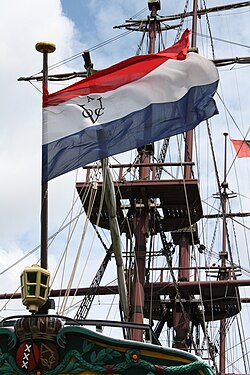Niderland Ost Hind Sirketi - Wikipedia
Niderland Ost Hind Sirketi - Wikipedia - Haqqında Məlumat
Niderland Ost-Hind Şirkəti, rəsmi olaraq Birləşmiş Ost-Hind Şirkəti (nid. Vereenigde Oostindische Compagnie; VOC), 17-ci əsrin əvvəllərində bir neçə rəqib holland ticarət şirkətinin (voorcompagnieën) hökumət tərəfindən yönəldilmiş və birləşməsi ilə qurulmuş erkən meqakorporasiya idi.[1][2] Proto-sənayeləşmə dövründə [3] Muğal Hindistanı ilə ticarət etmək üçün qurulmuş bir şirkət olaraq 20 mart 1602-ci ildə yaradıldı.[4] Əsasən də ən inkişaf etmiş Benqal Subah olaraq bilinən bölgədən 50% -i toxuculuq və 80% ipək idxal edildi.[5][6][7][8][9]
| Niderland Ost-Hind Şirkəti | |
|---|---|
| |
 | |
 | |
 | |
| Ümumi məlumatlar | |
| Ölkə | Niderland |
| Yaradılma tarixi | 20 mart 1602 |
| Əvvəlki qurum |
Voorcompagnieën
|
| Ləğv edilib | 31 dekabr 1799 |
| Tabelik | Yeddi Birləşmiş Əyalət Respublikası |
| Ünvan | Oost-Indiş Huis,Amsterdam (qlobal), Batavia (xaricdə) |
| Rəhbərlik | |
| Rəhbər | İohan van Oldenbarnevelt |



İstinadlar
redaktə- ↑ Gelderblom, Oscar; de Jong, Abe; Jonker, Joost (2011), 'An Admiralty for Asia: Business Organization and the Evolution of Corporate Governance in the Dutch Republic, 1590–1640,'; in J.G. Koppell (ed.), Origins of Shareholder Advocacy. (New York: Palgrave Macmillan, 2011), pp. 29–70. Gelderblom, Jonker & de Jong (2010): "The hot rivalry between the voorcompagnieën undermined the country's fragile political unity and economic prosperity, and seriously limited the prospects of competing successfully against other Asian traders from Europe. ... According to Willem Usselincx, a large merchant well versed in the intercontinental trade, the VOC charter was drafted by bewindhebbers bent on defending their own interests and the States-General had allowed that to pass so as to achieve the desired merger (Van Rees 1868, 410). An agreement was finally reached on March 20th, 1602, after which the Estates General issued a charter granting a monopoly on the Asian trade for 21 years (Gaastra 2009, 21–23)."
- ↑ Unoki, Ko (2012), 'A Seafaring Empire,'; in Mergers, Acquisitions and Global Empires: Tolerance, Diversity and the Success of M&A, by Ko Unoki. (New York: Routledge, 2013), pp. 39–64
- ↑ Richards, John F. The Mughal Empire. Cambridge University Press. 1995. ISBN 978-0-521-56603-2.
- ↑ Leslie A. Clarkson. Proto-Industrialization: The First Phase of Industrialization?. Macmillan International Higher Education. 1985. ISBN 9781349065608.
- ↑ Junie T. Tong. Finance and Society in 21st Century China: Chinese Culture Versus Western Markets. CRC Press. 2016. səh. 151. ISBN 978-1-317-13522-7.
- ↑ John L. Esposito, redaktorThe Islamic World: Past and Present. Volume 1: Abba - Hist. Oxford University Press. 2004. səh. 174. ISBN 978-0-19-516520-3. 2017-12-20 tarixində arxivləşdirilib. İstifadə tarixi: 2019-08-03.
- ↑ Nanda, J. N (2005). Bengal: the unique state. Concept Publishing Company. p. 10. 2005. ISBN 978-81-8069-149-2.
Bengal [...] was rich in the production and export of grain, salt, fruit, liquors and wines, precious metals and ornaments besides the output of its handlooms in silk and cotton. Europe referred to Bengal as the richest country to trade with.
- ↑ Om Prakash, "Empire, Mughal Arxivləşdirilib 2022-11-18 at the Wayback Machine", History of World Trade Since 1450, edited by John J. McCusker, vol. 1, Macmillan Reference USA, 2006, pp. 237–240, World History in Context. Retrieved 3 August 2017
- ↑ Indrajit Ray. Bengal Industries and the British Industrial Revolution (1757-1857). Routledge. 2011. 57, 90, 174. ISBN 978-1-136-82552-1. 2016-05-29 tarixində arxivləşdirilib. İstifadə tarixi: 2019-08-03.
- ↑ Steensgaard, Niels (1982), 'The Dutch East India Company as an Institutional Innovation,'; in Maurice Aymard (ed.), Dutch Capitalism and World Capitalism / Capitalisme hollandais et capitalisme mondial [Studies in Modern Capitalism / Etudes sur le capitalisme moderne], pp. 235–257
- ↑ Von Nordenflycht, Andrew (2011), 'The Great Expropriation: Interpreting the Innovation of "Permanent Capital" at the Dutch East India Company,'; in Origins of Shareholder Advocacy, edited by Jonathan G.S. Koppell. (Palgrave Macmillan, 2011), pp. 89–98
- ↑ Shah, Anup. "The Rise of Corporations". GlobalIssues.org. 5 December 2002. 22 September 2022 tarixində arxivləşdirilib. İstifadə tarixi: 28 August 2018.
Anup Shah (2002): "Today we know that corporations, for good or bad, are major influences on our lives. For example, of the 100 largest economies in the world, 51 are corporations while only 49 are countries, based on a comparison of corporate sales and country GDPs. In this era of globalization, marginalized people are becoming especially angry at the motives of multinational corporations, and corporate-led globalization is being met with increasing protest and resistance. [...]"
Xarici keçidlər
redaktə- Vikianbarda Niderland Ost-Hind Şirkəti ilə əlaqəli mediafayllar var.
- Oldest share – the oldest share in the world (VOC 1606)
- "A taste of adventure – The history of spices is the history of trade", The Economist, 17 December 1998.
- Voyages by VOC ships to Australia Arxivləşdirilib 2006-04-05 at the Wayback Machine
- "Why did the Largest Corporation in the World go Broke?"
- Death of an East Indiaman Arxivləşdirilib 2020-07-27 at the Wayback Machine
- VOC voyages – online database of voyages of VOC ships
- Atlas of Mutual Heritage – online atlas of VOC and WIC settlements
- Database of VOC crew members Arxivləşdirilib 2016-03-22 at the Wayback Machine
- VOC Historical Society
- VOC Warfare

